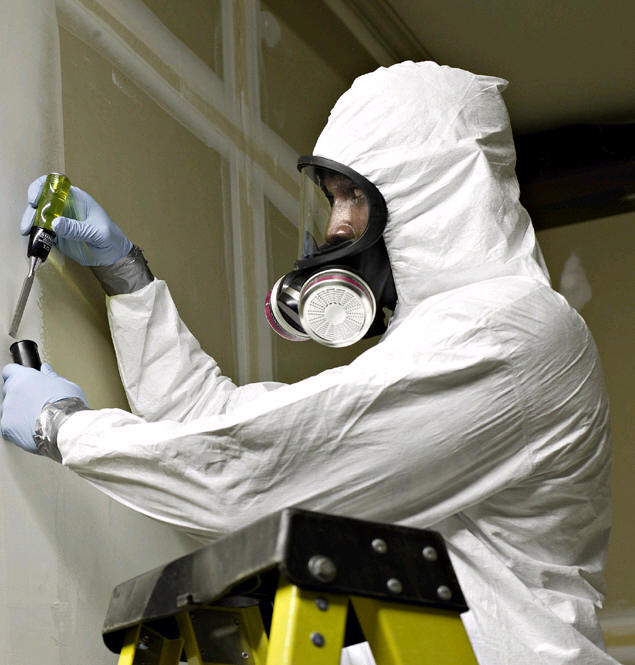Asbestos Testing: In-depth Evaluations to Guarantee Complete Safety
The Full Process of Accredited Asbestos Checking to Ensure Residential Property Conformity
In the realm of building management and compliance, the procedure of recognized asbestos screening stands as a vital element to make sure the safety and wellness of passengers. From the preliminary assessment to the last analysis of results, each stage plays a vital duty in determining the visibility of asbestos within a building.
Accredited Asbestos Screening: Preliminary Evaluation
In carrying out the preliminary assessment for accredited asbestos testing, a thorough assessment of the residential or commercial property's materials is essential to properly identify potential asbestos-containing products. This important step entails visually inspecting all locations of the home, including ceilings, walls, floor covering, insulation, and other structure materials that may harbor asbestos. Unique attention is offered to products that are susceptible to harm or disturbance, as these scenarios can release harmful asbestos fibers into the air. Furthermore, sampling of thought materials might be required to validate the existence of asbestos via lab evaluation.
Certified asbestos assessors adhere to rigorous protocols set by governing bodies to ensure the accuracy and reliability of the screening process. By carefully recording findings and using innovative testing techniques, assessors can give home proprietors with a detailed record outlining the existence of asbestos, if any kind of, and the advised steps for mitigation or elimination. This first assessment sets the foundation for succeeding actions to deal with asbestos problems and ensure the safety and compliance of the residential property.
Example Collection Procedures for Asbestos Evaluating
Effective sample collection treatments are important in guaranteeing precise asbestos screening results and conformity with governing criteria. When gathering samples for asbestos testing, it is crucial to adhere to rigorous procedures to decrease the threat of contamination and make certain the reliability of the outcomes.
To start with, it is very important to determine the thought asbestos-containing materials (ACMs) and prioritize tasting locations based on factors such as the material's condition, ease of access, and potential for disruption. Asbestos Testing. Samples should be accumulated from different locations within the property to give a detailed evaluation of asbestos visibility
During sample collection, certified specialists should use suitable personal protective equipment (PPE) to protect versus asbestos direct exposure. They need to make use of clean tools, such as disposable gloves and plastic sheeting, to avoid cross-contamination between samples. Examples should be meticulously gathered using a defined technique, such as damp wiping or coring, and firmly sealed in closed containers to preserve their honesty throughout transport to the lab for evaluation.
Lab Evaluation Process for Asbestos Examples
Upon completion of the example collection process, the asbestos samples are carefully delivered to accredited laboratories for precise analysis. The very first action in the research laboratory evaluation procedure is sample prep work, where the accumulated examples are meticulously refined to extract the asbestos fibers.

As soon as the evaluation is full, a detailed report is generated, describing the findings and verifying whether asbestos exists, the kind of asbestos fibers determined, and the concentration levels. This info is important for residential property proprietors to take the required steps to make sure compliance with asbestos policies and protect the health and wellness of residents.

Reporting and Interpretation of Asbestos Test Results
Accredited asbestos testing Recommended Reading laboratories offer thorough records that supply essential insights into the presence, type, and concentration levels of asbestos fibers discovered in samples collected from homes. These reports are vital for homeowner and managers to comprehend the risk positioned by asbestos and make informed decisions concerning its monitoring or elimination. The reports usually include information on the methods made use of for screening, the areas where samples were taken, the sort of asbestos identified (such as chrysotile, amosite, or crocidolite), and the focus degrees of asbestos fibers found.
Translating these results requires expertise to view publisher site analyze the possible health and wellness risks associated with asbestos direct exposure, figure out the suitable course of action, and make certain governing compliance (Asbestos Testing). Depending on the searchings for, suggestions might range from proceeded monitoring and upkeep to encapsulation or total asbestos abatement. Property proprietors ought to meticulously examine these reports and talk to asbestos specialists to establish a comprehensive prepare for dealing with any kind of asbestos problems recognized
Making Sure Residential Or Commercial Property Conformity With Asbestos Laws
To keep adherence with asbestos policies, homeowner must carefully carry out measures to make certain compliance with suitable laws and standards. This consists of performing regular asbestos examinations by accredited experts to recognize any type of visibility of asbestos-containing materials within the home. As soon as asbestos is identified, building owners have to adhere to asbestos management plans that outline proper containment, removal, or encapsulation procedures to stop direct exposure and spread of asbestos fibers. Conformity also includes maintaining thorough records of asbestos testing, upkeep, and elimination tasks for inspection purposes.
Building proprietors need to give asbestos understanding training to workers and residents to reduce the danger of asbestos direct exposure and ensure proper handling of products that might contain asbestos. Additionally, it is crucial to pop over to this site stay informed concerning any kind of updates or adjustments in asbestos guidelines to adjust management techniques as necessary. By proactively attending to asbestos conformity needs, homeowner can create a safe setting for passengers and reduce potential lawful and wellness dangers associated with asbestos direct exposure.
Final Thought
To conclude, certified asbestos testing is a critical process for making certain residential property compliance with regulations. The first evaluation, sample collection procedures, research laboratory evaluation, and interpretation of outcomes are very important steps in this procedure. By complying with these procedures, residential property proprietors can identify and resolve any type of asbestos hazards existing, shielding the health and wellness of residents and keeping compliance with governing requirements.